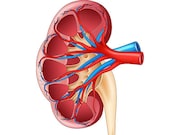Renal pelvis dilatation persisting in later pregnancy or after birth tied to increased risk for later admission
THURSDAY, Aug. 15, 2019 (HealthDay News) — Renal pelvis dilatation (RPD) at the fetal anomaly scan (FAS) and persistent dilatation in later pregnancy or postpartum is associated with an increased risk for hospital admission in early childhood, according to a study published online July 31 in PLOS Medicine.
Lisa Hurt, M.B.Ch.B., Ph.D., from the Cardiff University School of Medicine in the United Kingdom, and colleagues examined whether RPD persistence or its characteristics are associated with the risk for hospital admission. Data were included for singleton babies born between Jan. 1, 2009, and Dec. 31, 2011. The outcome was hospital admission for urinary tract causes in the first three years of life; 21,239 children were included in the analysis: 138 with RPD and 21,101 without.
The researchers observed a significantly increased risk for at least one hospital admission for those with RPD versus those without (conditional hazard ratio [cHR], 7.23; 95 percent confidence interval [CI], 4.31 to 12.15; P < 0.001). Children with RPD at the FAS and later dilatation and children without RPD at the FAS who had later dilatation had an increased risk for hospital admission (cHRs, 25.13 [95 percent CI, 13.26 to 47.64; P < 0.001] and 62.06 [95 percent CI, 41.10 to 93.71; P < 0.001], respectively) compared with children without RPD. There was no correlation seen with hospital admissions for children with RPD at the FAS but no dilatation in later pregnancy or postpartum (cHR, 2.16; 95 percent CI, 0.69 to 6.75; P = 0.185), except when the initial dilatation was bilateral (cHR, 4.77; 95 percent CI, 1.17 to 19.47; P = 0.029).
“Further studies should examine whether other characteristics at the FAS could improve the detection of renal pathology during antenatal screening,” the authors write.
Copyright © 2019 HealthDay. All rights reserved.








